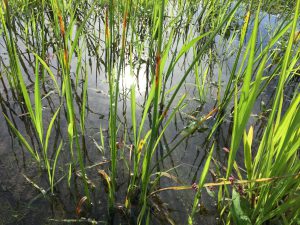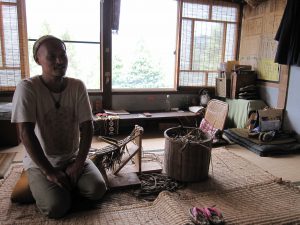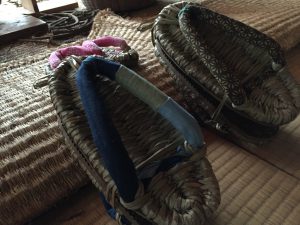昔から使われてきた生活雑貨から見える循環型社会における課題/ Encouraging a recycle-based society through old houseware items/ 从古来使用的生活杂货看循环型社会的课题

日本の高温多湿な風土の中で培われてきた草履を作るお百姓さんが、四国にもいることを聞き、取材で訪問した。達痲工房の寺田さんは、香川と徳島の県境集落で、注文を受けて編んだオーダーメイド草履を全国のお客さんに販売しながら、お百姓さんを続けている。

四国内で、自身で七島いを育てながら草履を編むことを生業にしている人は、彼だけだと聞いた。七島いは、カヤツリグサ科でシチトウ(別名リュウキュウイ)という。古代、エジプトの紙などにも使われる「パピルス」の仲間で、古くは現在のトカラ列島で栽培され、栽培用として国内に持ち込まれ普及したのが始まりと言われている。
通気性が良く、摩擦摩耗にも強く、使い込むほどに美しい艶が出るのが特徴で、琉球畳の畳表や仏間の畳、柔道畳などで使われていた。そんなシチトウは、い草や化学繊維の導入で需要が減るとともに、海外からの安い原料輸入の影響を受け、現在、日本国内での生産はもはや風前の灯火となっている。主な生産地の大分県においても、高齢化等の影響で生産の継続が年々厳しくなっている。

そんな希少草履の耐久性は2年程とのこと。鼻緒や靴底のメンテナンスを行いながら、除々に足に馴染んだ草履を長く大事にはく。天地の恵みをふんだんに受けた草履は、現代の靴に自分の足を合わせるのとは、逆の発想である。
SDGs(持続可能な開発目標)にある、生産と消費が注目されている。草履生産と消費サイクルにおいて、持続可能性の実現が難しい状況にありながら、寺田さんは何とかこの生業を基軸とした百姓生活の持続可能なものにするため、挑戦を続けている。
市民のライフスタイルや消費の変化が、どこまでその挑戦に答えることができるのか。草履の事例だけでなく、さまざまな伝統文化の継承においても同じ課題を抱えていることを改めて実感した。
■Encouraging a recycle-based society through old houseware items
Ehime Global Network went to interview a farmer, Mr. Terada, who makes custom-made zori (Japanese traditional sandals) for customers all around Japan, while still doing his farmer’s job in a village located on the border between Tokushima and Kagawa prefectures. He is the only man in Shikoku who grows Nanashima rush – a type of plant in the family of grasses – and makes zori to live. The rush is scientifically called Cyperus monophyllus Vahl and it is in a same category with papyrus which was used in ancient Egypt. The rush was grown in Tokara archipelago and brought into the Japanese mainland for cultivation later. The rush is used to make surface of Ryukyu-Tatami, and tatami floorings for use in Buddhism rooms, judo areas, etc. because of its high air permeability, high resistance to frictional wear and a feature which it gets a more beautiful luster the longer you use it. The production of Nanashima rush in Japan is now in severe decline due to reduced demand caused by synthetic fibers and cheap import material. It gets harder and harder to produce the rush even in Oita, the main production area.
The durability of the rare zori is around two years. Wear a pair of zori for a long time with care and maintenance of the thong and the sole so it gets to fit and become a part of your body. Wearing the zori with the favor of Mother Nature is a completely different idea from fitting modern day shoes.
Production and consumption are on SDGs and getting more and more attention today. The situation of the circle of zori production and consumption doesn’t look great to achieve sustainability but Mr. Terada keeps trying to make his farming life sustainable.
How much the change of people’s lifestyle and consumption can answer the challenge? I realized not only zori but every other tradition and their inheritance faces a similar problem.
■从古来使用的生活杂货看循环型社会的课题
听说四国也有制作日本高温潮湿的风土培育出来的草鞋的农人,于是去采访了他。达麻工房的寺田先生,在香川县和德岛县境的村落里一边接受订单、编织定制草鞋、向来自全国的客人们贩售,一边继续务农。
据说,他是四国唯一自己种植茳芏并且以编织草鞋为生的人了。茳芏读作jiāng dù,跟古埃及草纸使用的纸莎草「papyrus」同属莎草科,古时现今的吐噶喇列島有栽培,带到国内栽培后开始普及。
因其具有通气性好、不易磨损、越用越有光泽的特征,常用于琉球榻榻米的表面、佛堂的榻榻米及柔道榻榻米。由于化学纤维的引进,茳芏的需求减少,同时,受到海外原料价格低廉的影响,日本国内的生产已经近乎绝迹。主产地大分县也因高龄化影响,形势一年比一年严峻。
如此稀有的草鞋,有两年左右的耐久性。细心养护草屐带和鞋底,让草鞋逐渐与脚相合,就能穿上很久。草鞋踏受天地恩惠,与符合自己脚大小的现代鞋履相比,可以说是相逆的概念了。
由于符合可持续发展目标,草鞋的生产和消费受到了瞩目。尽管要想实现其循环持续,现状还很艰难,但寺田先生无论如何也坚持面对挑战,坚持以此为基础的农民生活。
市民的生活方式、消费的变化,应对这样的挑战,能走到哪一步呢。不仅仅是草鞋一例,近来感到各种各样的传统文化都面对着相同的课题。



